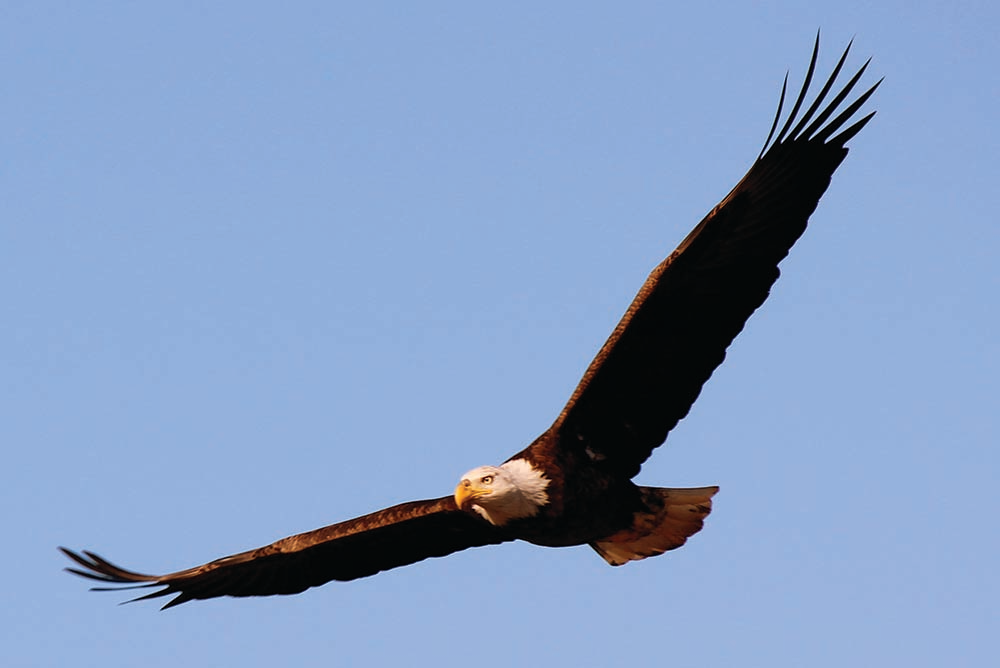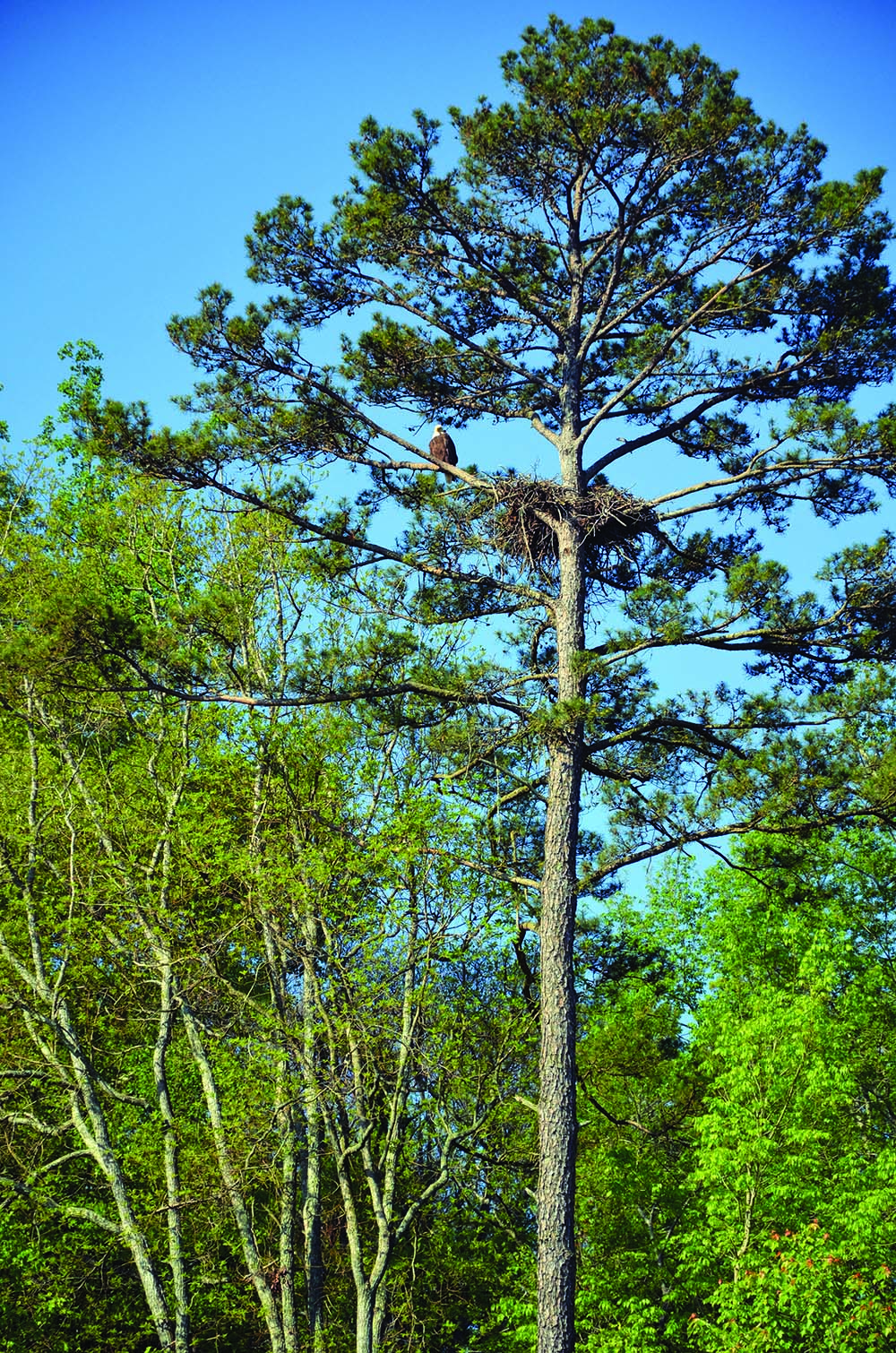Majestic national birds are flourishing again in Alabama

By John N. Felsher
When America adopted the bald eagle as its national symbol in 1782, the country may have had as many as 100,000 nesting eagles. Since that day, though, the American people haven’t always treated the national symbol with reverence.
Many people considered eagles nothing more than scavengers or predators to be exterminated. They almost succeeded. By 1963, fewer than 500 nesting pairs remained in the lower 48 contiguous states, none in Alabama.
“Historically, eagles were found everywhere in Alabama,” says Carrie Threadgill, the Nongame Wildlife Program coordinator for the Alabama Division of Wildlife and Freshwater Fisheries. “With the rise in some pesticide usage and other threats, the eagle population declined drastically in the early 20th century.”
Beginning with the Bald Eagle Protection Act of 1940, followed by an amendment including golden eagles in 1962, a series of laws began to protect eagles and other raptors. Finally, President Richard Nixon signed the Endangered Species Act of 1973, putting eagles on the Endangered Species List.
A year earlier, the nation banned DDT. The powerful agricultural pesticide washed into rivers and lakes where fish-eating birds like eagles and pelicans ingested it. The poison weakened eggshells so feathered parents could not incubate their eggs without crushing them. With federal protection and the DDT ban, eagle populations began to soar. To hasten this rebound, Alabama and other states began reintroduction programs.
“After the Nongame Wildlife Program was created in 1984, one of the first projects we did was the bald eagle reintroduction program,” Threadgill says. “In 1985, an eagle might occasionally migrate through the state, but there were no breeding pairs in Alabama at the time.”

Bringing eagles back
In what is called a “hacking” program, Alabama biologists took young bald eagles from Florida and put them in “hacking towers,” or large enclosed artificial eagle nests. The state built six towers along major river systems in Alabama. Once old enough to fend for themselves, the birds were released into the wild.
“At that time, bald eagles were doing fairly well in Florida,” Threadgill recalls. “The goal was to raise the babies without human interaction. Once we released them, we hoped they would become imprinted to that area, stay and breed. The first confirmed successful eagle nesting since 1962 occurred in 1991.”
From 1985 to 1991, the state released 91 eagles. By 1992, the U.S. bald eagle population grew to more than 100,000 with about half of them in Alaska. In 1995, the U.S. Fish and Wildlife Service reclassified bald eagles from “endangered” to “threatened” and removed the birds from the Endangered Species List entirely on June 28, 2007, but eagles remain protected.
“Eagles are doing great in Alabama now,” Threadgill says. “We get eagle sightings in every county throughout the year. We have confirmed records of eagles breeding in 49 counties, but we are fairly certain that they are nesting in every county in Alabama. We have more than 200 resident nesting pairs in the state, but during the winter, many more birds migrate down from other states.”
The highest bald eagle concentrations in Alabama occur along the Tennessee River and associated lakes like Pickwick, Wheeler and Guntersville in the northern part of the state. But you may see eagles on other lakes or rivers across Alabama. Several nesting pairs live in the Mobile-Tensaw Delta near Mobile.
Golden eagles in Alabama
Bird watchers might also see golden eagles in Alabama. Golden eagles traditionally live in the canyons and mountains of western states and Canada, but some winter in the Southeast, including Alabama. Slightly larger than bald eagles, golden eagles sport a light golden “cape” on their heads and upper backs rather than the distinctive white top of their cousins. Many people mistake goldens for immature bald eagles that haven’t developed their iconic white headgear.
“We have a wintering population of golden eagles, but not a breeding population,” Threadgill says. “Over the past 100 years or so, we’ve had a handful of records of goldens visiting the state, but we are seeing more of them now. Goldens actually have two populations in North America, an eastern and a western population. The eastern population is more migratory. They breed in Canada and winter in the South. Some may even winter farther south than Alabama.”
Since 2012, Alabama has joined 15 other eastern states in projects to monitor golden eagle movements. Researchers put up game cameras in several locations to spot the eagles and trapped 12 of them in Alabama. The researchers fitted the eagles with radio-tracking devices and released them.
“The golden eagle population in Alabama is a lot higher than we first expected,” Threadgill says. “With the transmitters, we’ve tracked golden eagles to the northern provinces of Canada around Hudson Bay.”
Money for eagle research and other projects conducted by the Alabama Nongame Wildlife Program comes primarily from the sale of hunting licenses and excise taxes on guns and ammunition purchased by sportsmen. The federal government reimburses states a portion of those excise taxes collected based upon the number of licenses sold.
 Want to see eagles in the wild or up close?
Want to see eagles in the wild or up close?
Eagle Awareness Weekends at Lake Guntersville State Park (alapark.com/lake-guntersville-state-park) offer people outstanding opportunities to spot raptors and other birds. The event runs over four straight weekends from Jan. 25 through Feb. 17. People may participate in many different activities and presentations or explore on their own.
“Winter is the prime time to see eagles in Alabama,” says Michael Ezell, the park naturalist. “We host some guided field trips. We also bring in experts to present programs on birds of prey, birds in general and other topics like reptiles and plants. Some experts bring in birds that have been injured and rehabilitated, but cannot be released into the wild so people can see them up close.”
All Eagle Awareness Weekends events are free and open to the public. The park offers a variety of lodging options from hotel-style rooms in the resort to camping.
“I can almost guarantee that people will see an eagle around Lake Guntersville at this time,” Ezell says. “We have two active nests in the park. During the 2018 Eagle Awareness Weekends, we had 66 eagle sightings in two days.”
For more on Eagle Awareness Weekends and a complete schedule, see alapark.com/Lake-Guntersville-State-Park-Eagle-Awareness-Weekends-2019 or call Ezell at 256-762-3417.




